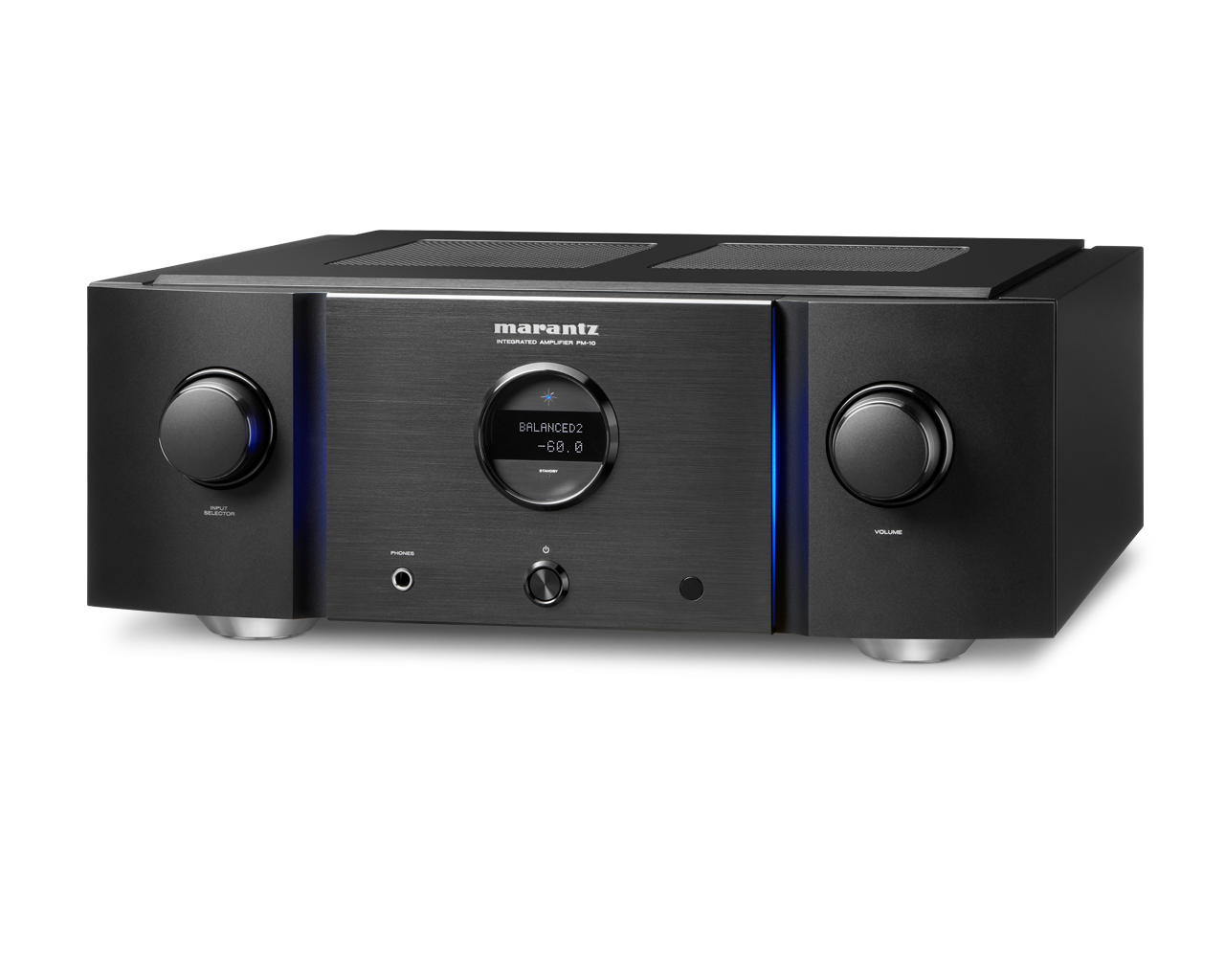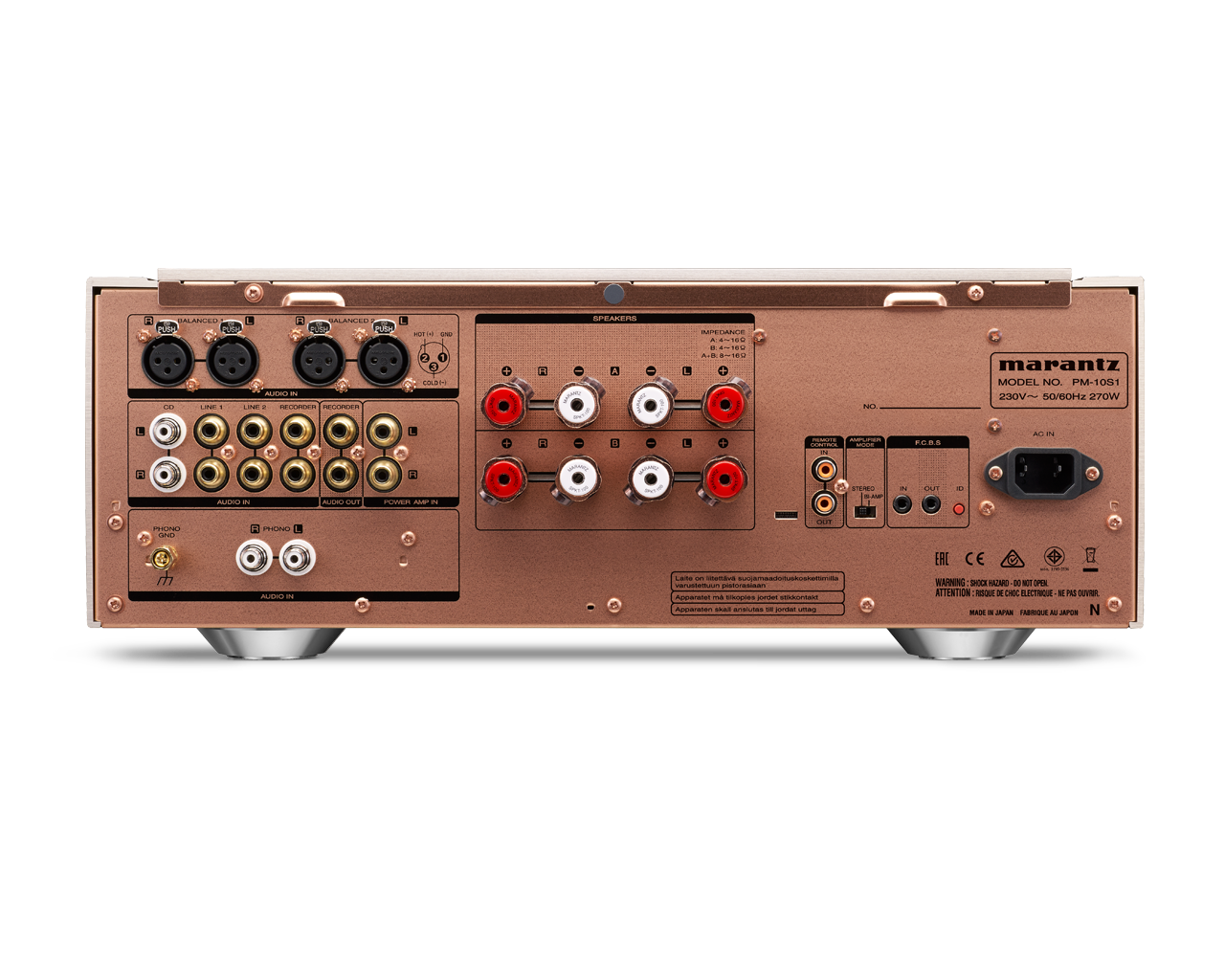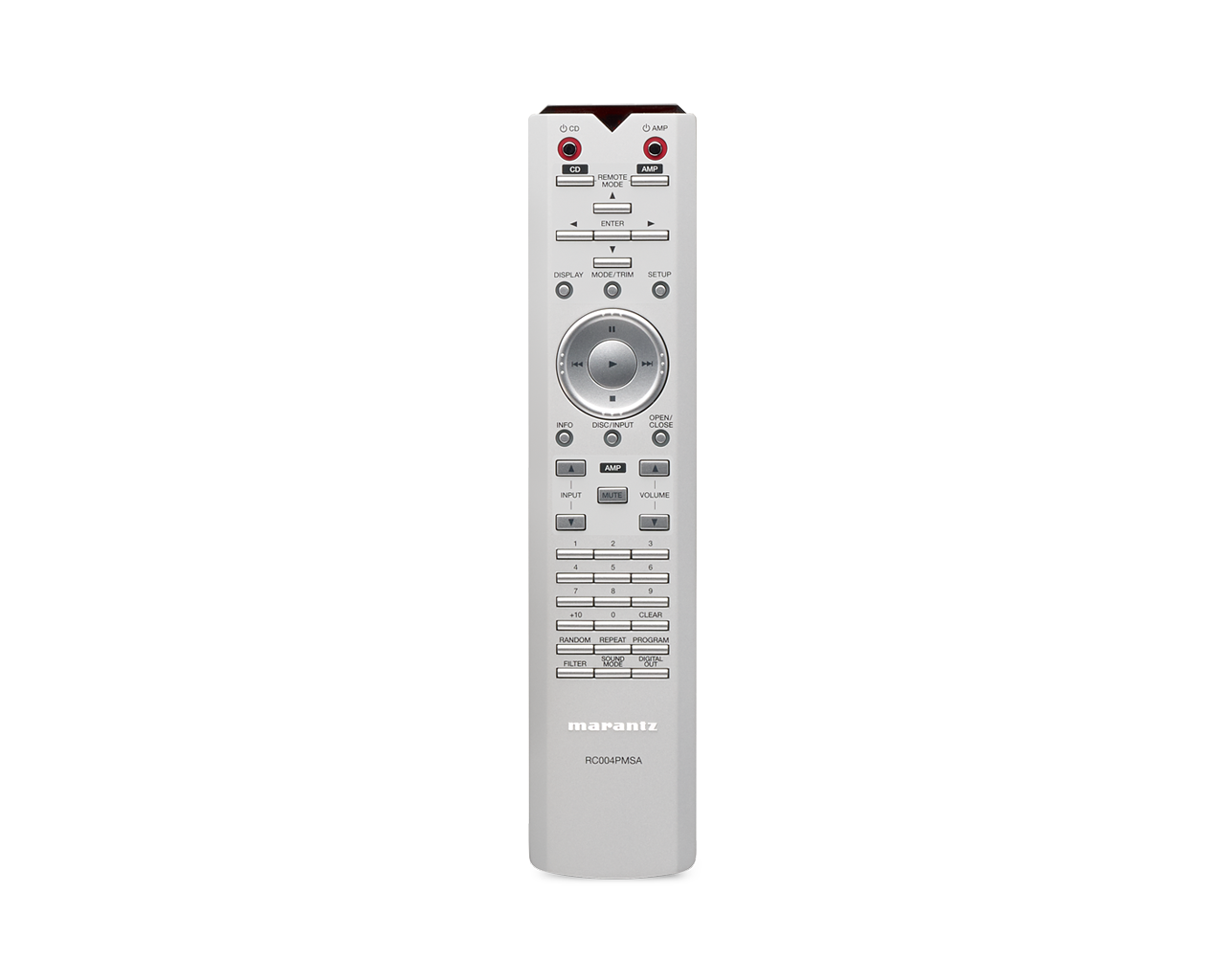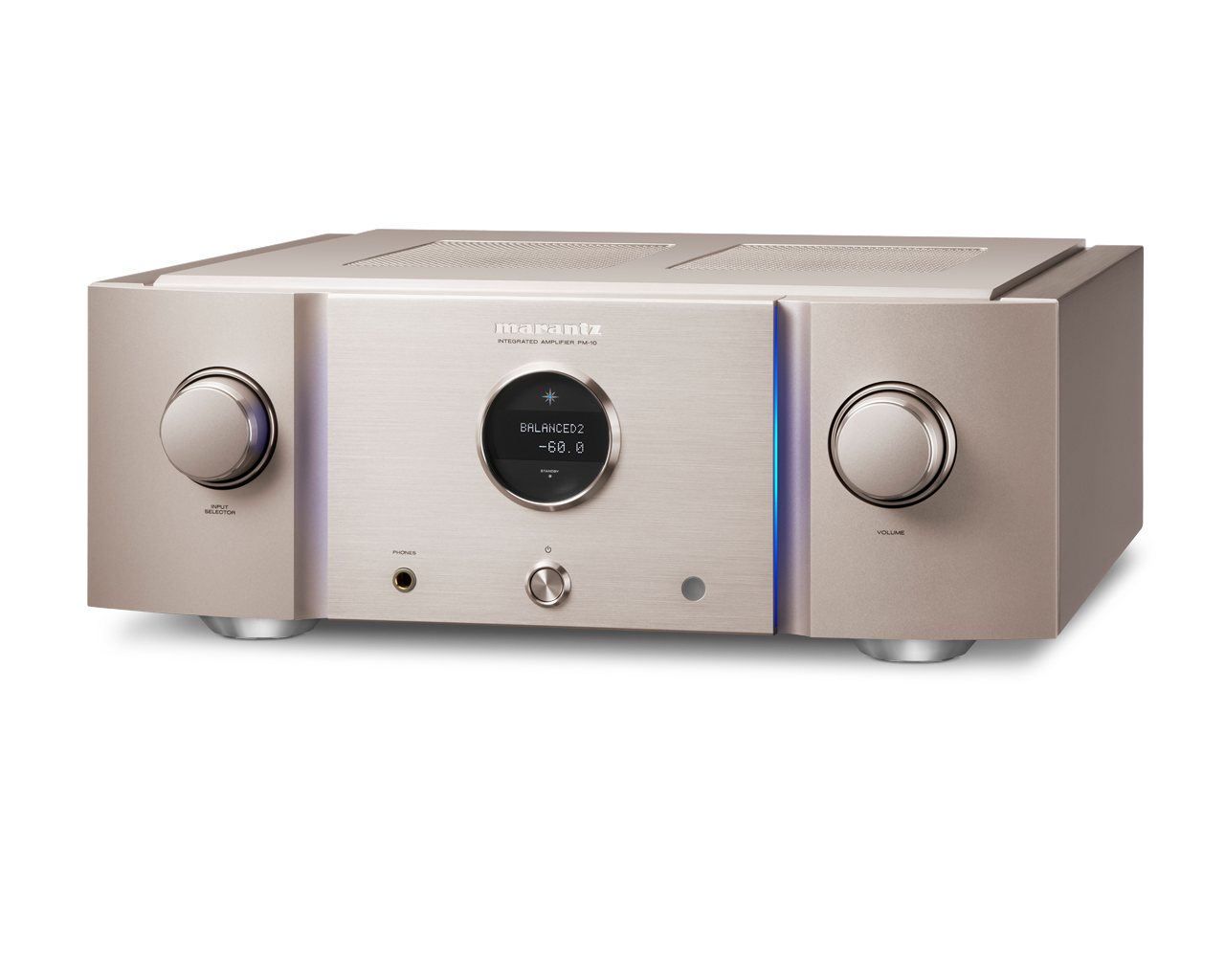Description
Marantz PM-10
high-end uncompromising stereo amplifier
The Marantz PM-10 is the manufacturer's flagship model and represents Marantz's design philosophy and expertise at its purest.
Key details:
-
New reference class integrated stereo amplifier
-
Implemented with four power amplifiers (two monolithic to one channel)
-
Signal path realized with Marantz's own True Balanced Concept implementation
-
200W per channel into 8 ohms, 400W per channel into 4 ohms
-
A power supply with a high power output
-
Fully balanced signal path
-
The preamplifier side is implemented with a Marantz HDAM processor
-
Separate power supplies for the pre-stage and the final stage
-
High-quality MM and MC phono amplifier
-
High-quality construction with reinforced copper body, 5 mm thick aluminum cover and speaker connections made of pure copper
Optimal design
In order to achieve such high-quality sound reproduction, each part of the amplifier must be optimally designed to perform its specific task. Typically, integrated stereo amplifiers use a single transistor with a separate current transformer for both the preamplifier and the power stage. The PM-10 amplifier has a separate current transformer for the preamplifier and for each power amplifier channel. The amplifier also has its own current transformer for the microprocessor, which takes care of the volume, input components, etc. In this case, the possible interference sound from these does not affect the signal path.
Truly analog
The PM-10 is a truly analog amplifier: many competitors today have dac features and class-d power amplifiers. However, Marantz wants to keep things simple and high-quality with its analog implementation. This is why DAC features are found in Marantz CD/SACD and network players and not in amplifiers. This guarantees a trouble-free amplifier implementation as much as possible. The PM-10 amplifier also has a 'Purest Mode' which, when switched on, stops the amplifier's unnecessary functions and circuit boards, allowing the incoming audio signal to pass through the amplifier as undisturbed as possible. The PM-10 amplifier also has a Power AMP Direct input, which is used to bypass the preamplifier side and the amplifier can only be used as a power amplifier.
Fully balanced structure
With the fully balanced structure of the PM-10 amplifier, a free and undisturbed passage of the signal through the amplifier is achieved. Even the use of longer cables does not increase interference in the balanced structure. The amplifier has two pairs of balanced inputs as well as an unbalanced line input and a high-quality phono input. The signal coming from these inputs is converted to balanced before going to the power stage.
Balanced and bridged power stage
Marantz's goal was to make the PM-10 produce the most authentic sound possible, as well as the ability to drive the world's most demanding speakers effortlessly. In order to achieve this, Marantz implemented a fully balanced signal path in the PM-10 from the preamplifier to the main amp all the way to the speaker outputs. Another decisive factor is the bridged terminal stages. In a typical stereo amplifier, one speaker is driven by the positive and negative parts of a single-channel power amplifier circuit. A bridged amplifier uses two power stages per channel. In simplified terms, one power stage pushes the speaker elements forward, the other pulls them back. In this way, the amplifier reproduces sound more accurately, dynamically and naturally.
Quality selected components
Marantz has been known throughout history for its ability to select the best possible components available for its Premium products - and if it can't find what it wants, Marantz makes it itself. This is how the Hyper Dynamic Amplifier Module (HDAM) was born. Marantz wasn't satisfied with the preamp circuit boards on the market, so they designed it themselves. The components were selected as a result of long listening sessions, which were conducted in Marantz's European and Japanese listening rooms, and after proving it to be a great front-end circuit, Marantz has also used it in its non-Premium products. The PM-10 amplifier uses the latest form of the circuit, HDAM SA3, which takes into account the conditions required for high-resolution audio playback. The same HDAM SA3 pre-stage circuit is also used in the amplifier's phono input for MM and MC sound boxes.
Made to shine
The PM-10 stereo amplifier, like the SA/CD player SA-10 of the same series, is made of top materials, hand-selected components, a double-reinforced copper frame, which, thanks to its insulating properties, effectively isolates the effect of all mechanical and electronic interference on the sound. The devices also include SPKT-100+ speaker terminals designed and manufactured by Marantz themselves, which are pure copper. The devices also have sturdy aluminum legs. All decisions regarding design and implementation always follow Marantz's philosophy 'Because Music Matters'.
- Channels: 2
- Type: Dual mono
- Inputs: 7 pcs (Line 1, Line 2, Recorder, CD, Phono, Balanced 1, Balanced 2)
- Balanced income: 2 pcs
- Phono input: MM/MC
- Separate input when used as a power amplifier only: Yes
- Outputs: 1 (RCA)
- Headphone output: Yes
- Speaker connections: A / B / A+B
- Excitation signal input/output: Yes
- Output power: 2 x 200 W 8 ohm RMS / 2 x 400 W 4 ohm RMS
- Frequency response: 5 Hz to 50 kHz
- THD: 0.005%
- SNR: 111 dB (2V input)
- SNR as power amplifier: 113 dB
- Dimensions: W x H x D: 440 x 168 x 453 mm
- Weight: 21.5 kg
More information: Manufacturer's pages
Marantz offers an extended 5-year warranty for its Premium and Premium+ products, as long as the consumer registers ( https://www.marantz.com/fi-fi/ 5ywarranty ) of their product within 3 months from the date of purchase.
Below are the instructions in a nutshell:
- Consumers are interested in a Marantz product and become aware of the 5-year warranty via the brand website or the dealer
- Consumer Buys a Premium or Premium plus product and can register this on a dedicated registration page (within 3 months after purchase)
- Once all data is submitted, the consumer will receive a confirmation email with a proof of the registration
- When a product breaks, the consumer can go to the dealer/service center with the defective product, receipt and confirmation email
- Dealer/service center to check if the serial numbers match, and if the purchase date on the receipt matches the registration
- Once all is fine, the consumer qualifies for the extra warranty and the service can be executed free of charge.







